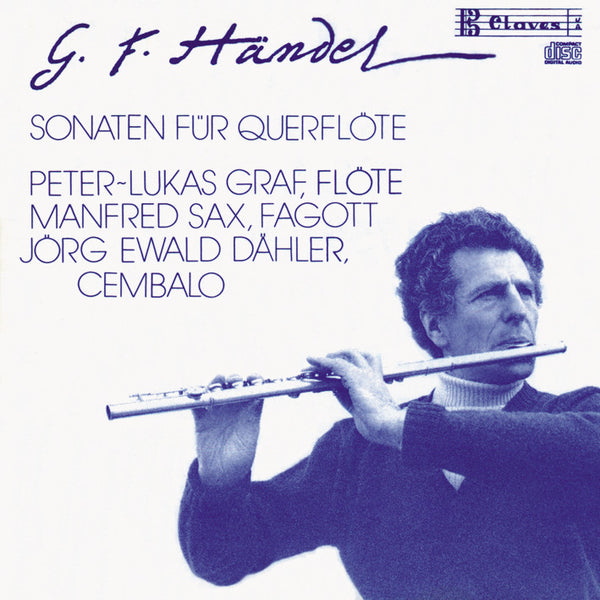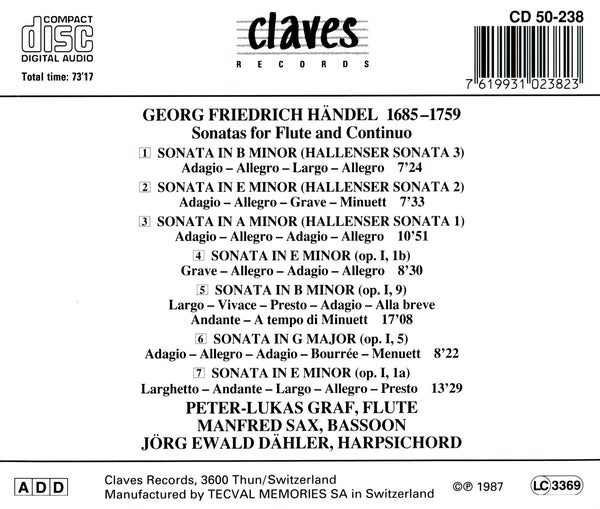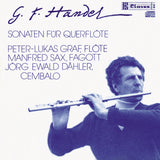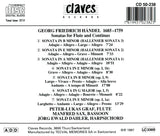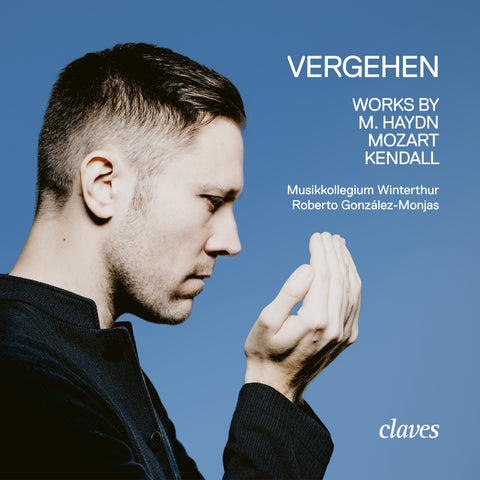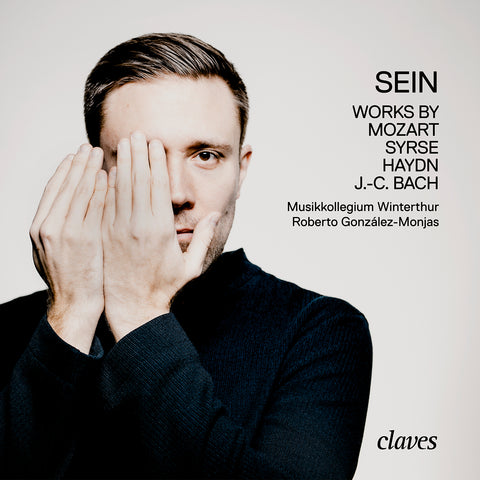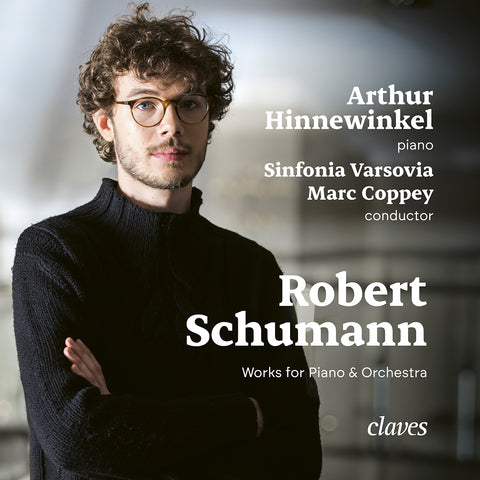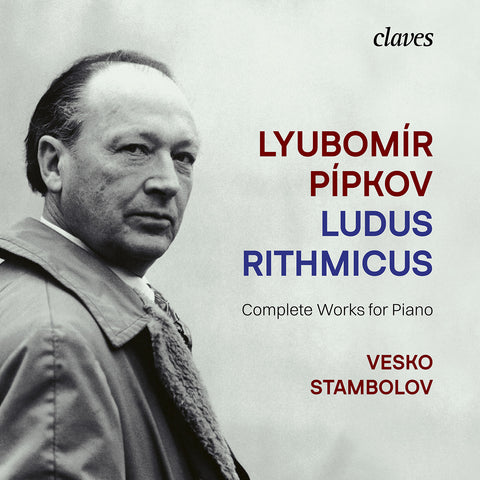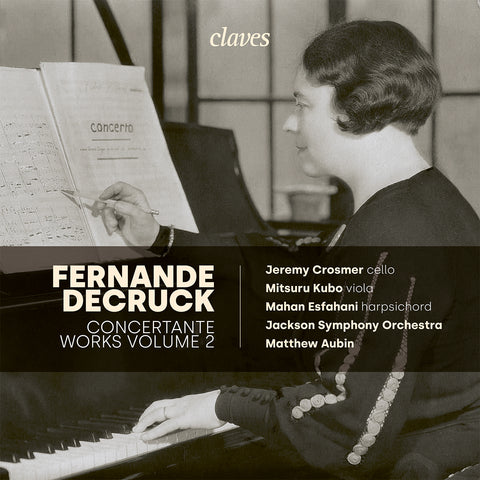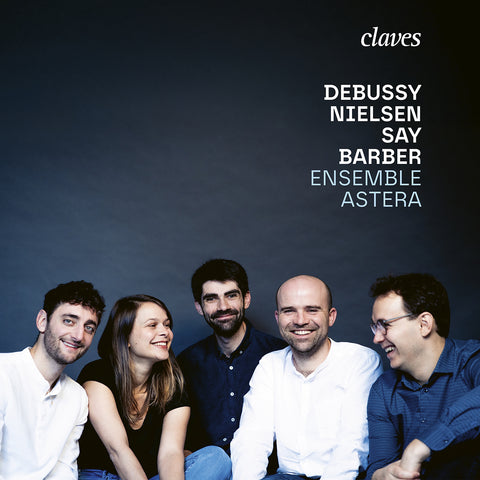(1987) G.F. Handel: Sonaten Für Querflöte
Category(ies): Ancient music Rarities
Instrument(s): Bassoon Flute Harpischord
Main Composer: Georg Friedrich Händel
CD set: 1
Catalog N°:
CD 0238
Release: 1988
EAN/UPC: 7619931023823
- UPC: 829410602860
This album is now on repressing. Pre-order it at a special price now.
CHF 18.50
This album is no longer available on CD.
This album has not been released yet. Pre-order it from now.
CHF 18.50
This album is no longer available on CD.
CHF 18.50
VAT included for Switzerland & UE
Free shipping
This album is no longer available on CD.
VAT included for Switzerland & UE
Free shipping
This album is now on repressing. Pre-order it at a special price now.
CHF 18.50
This album is no longer available on CD.
This album has not been released yet.
Pre-order it at a special price now.
CHF 18.50
This album is no longer available on CD.
CHF 18.50
This album is no longer available on CD.
G.F. HANDEL: SONATEN FÜR QUERFLÖTE
Apart from the Jazz and certain other modern compositions, hardly any music offers such a rich opportunity for improvisations as this type of sonata continuo. The harpsichord player experiences freedom first as obligation: he has to reproduce and respect with his right hand the given harmonies. The way of modulation, however, depends entirely on his ability and his creative capability. He is then free in choosing the tempo and the expression of the character of the different movements, their titles giving only a limited idea of the rendering.
He is also free in phrasing and articulating a melody which the composer has merely outlined. And last but least the soloist has an opportunity to use his imagination and spontaneity by the art of embellishment. It goes without saying that such liberty is only possible if it is based on an exact knowledge and a trained sense of style. The aim is to play the piece of music as lively as possible without falsifying it. As an example of this kind of interpretation we refer to the sonatas Opus 1, No. 1a and 1b in E minor: they begin with the same movement (larghetto resp. grave) and have also an allegro in common (4th movement), but the two identical pieces receive a completely different significance by the interpretation. The final movements of sonata Opus 1 No. 9 in H minor (andante, a tempo di minuett) may be mentioned as example for a spontaneous “double playing”: in the repetitions it comes to a dialogue by means of embellishment; the flutist and the harpsichord player receive ideas from their partner taking them up and thus apparently inspiring each other mutually.
Peter-Lukas Graf, flute
Born in Zurich. Studied music in Zurich, Paris and Munich. International prizes. Various activities as soloist and conductor all over the world. Recordings and broadcasts. Since 1973 professor at the Musikakademie Basel.
Manfred Sax, bassoon
Born in Munich. Studied music in Munich. Solo bassoonist of the “Tonhalle-Orchester” in Zurich. Member of several well-known chamber music ensembles.
Jörg Ewald Dähler, harpsichord
Born in Berne. Studied harpsichord in Freiburg/Germany. Prizewinner at the international competition of music in Munich. In charge of a class in harpsichord at the Berne Conservatory. Concerts in Switzerland and abroad as soloist, accompanist and conductor of the “Berner Kammerchor”. Recordings and broadcasts.
(1987) G.F. Handel: Sonaten Für Querflöte - CD 0238
The 12 sonatas for German flute and recorder take an important place in Händel’s works for chamber music. The present recording comprises those pieces which are especially dedicated to the German flute. Probably composed around 1711-12, the sonatas Opus 1 were printed for the first time in 1722. The so-called “Hallenser Sonaten” belong to the early works written by Händel. All these sonatas were “solos” for flute with a figured basso continuo. According to a performing tradition of the Baroque times, the basso played by the left hand of the harpsichord player is supported by a bassoon, which gives a clearer idea of the two voices in the composition than e.g. an accompanying bass-viola would do.
Apart from the Jazz and certain other modern compositions, hardly any music offers such a rich opportunity for improvisations as this type of sonata continuo. The harpsichord player experiences freedom first as obligation: he has to reproduce and respect with his right hand the given harmonies. The way of modulation, however, depends entirely on his ability and his creative capability. He is then free in choosing the tempo and the expression of the character of the different movements, their titles giving only a limited idea of the rendering.
He is also free in phrasing and articulating a melody which the composer has merely outlined. And last but least the soloist has an opportunity to use his imagination and spontaneity by the art of embellishment. It goes without saying that such liberty is only possible if it is based on an exact knowledge and a trained sense of style. The aim is to play the piece of music as lively as possible without falsifying it. As an example of this kind of interpretation we refer to the sonatas Opus 1, No. 1a and 1b in E minor: they begin with the same movement (larghetto resp. grave) and have also an allegro in common (4th movement), but the two identical pieces receive a completely different significance by the interpretation. The final movements of sonata Opus 1 No. 9 in H minor (andante, a tempo di minuett) may be mentioned as example for a spontaneous “double playing”: in the repetitions it comes to a dialogue by means of embellishment; the flutist and the harpsichord player receive ideas from their partner taking them up and thus apparently inspiring each other mutually.
Peter-Lukas Graf, flute
Born in Zurich. Studied music in Zurich, Paris and Munich. International prizes. Various activities as soloist and conductor all over the world. Recordings and broadcasts. Since 1973 professor at the Musikakademie Basel.
Manfred Sax, bassoon
Born in Munich. Studied music in Munich. Solo bassoonist of the “Tonhalle-Orchester” in Zurich. Member of several well-known chamber music ensembles.
Jörg Ewald Dähler, harpsichord
Born in Berne. Studied harpsichord in Freiburg/Germany. Prizewinner at the international competition of music in Munich. In charge of a class in harpsichord at the Berne Conservatory. Concerts in Switzerland and abroad as soloist, accompanist and conductor of the “Berner Kammerchor”. Recordings and broadcasts.
Return to the album | Read the booklet | Composer(s): Georg Friedrich Händel | Main Artist: Peter-Lukas Graf







